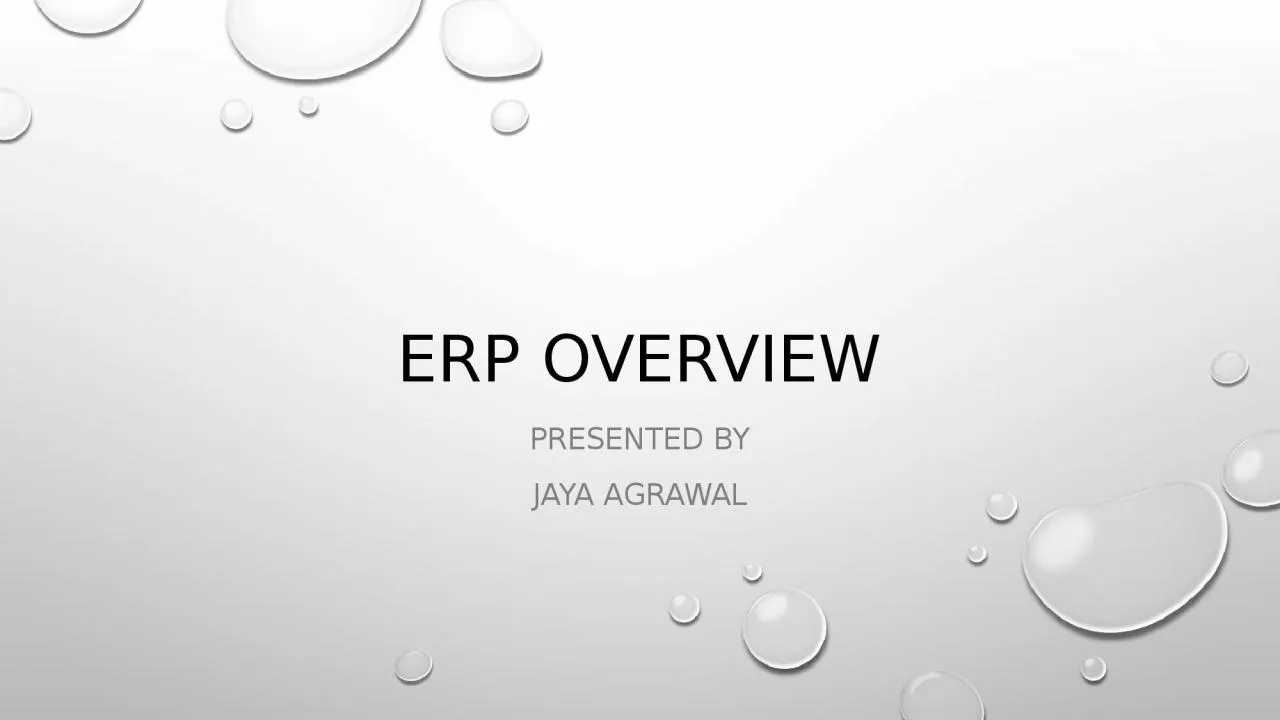

Jaya Agrawal Table of Contents What is ERP How do ERP systems work ERP Components An ERP Example Before ERP An ERP exmaple After ERP Why ERP Benefits of ERP LocalizationGlobalization ID: 1031453
Download Presentation The PPT/PDF document "ERP Overview Presented by" is the property of its rightful owner. Permission is granted to download and print the materials on this web site for personal, non-commercial use only, and to display it on your personal computer provided you do not modify the materials and that you retain all copyright notices contained in the materials. By downloading content from our website, you accept the terms of this agreement.
1. ERP OverviewPresented byJaya Agrawal
2. Table of ContentsWhat is ERPHow do ERP systems workERP ComponentsAn ERP Example: Before ERPAn ERP exmaple: After ERPWhy ERPBenefits of ERPLocalization/GlobalizationERP Projects and TimelinesHidden costs of ERPRisks with ERP ImplementationChallenges faced during ERP implementationBest Practices of ERP Implementation
3. What is ERPThe practice of consolidating an enterprise’s planning, manufacturing, sales and marketing efforts into one management system.Combines all databases across departments into a single database that can be accessed by all employees.ERP automates the tasks involved in performing a business process.
4. How do ERP systems work
5. ERP Components
6. An ERP Example: Before ERP
7. An ERP Example: After ERP
8. Why ERPMajor Reasons:To integrate financial data.To standardize manufacturing processes.To standardize HR information
9. Benefits of ERPImproving integration, flexibilityFewer errorsImproved speed and efficiencyMore complete access to informationLower total costs in the complete supply chainShorten throughput timesSustained involvement and commitment of the top managementReduce stock to a minimumEnlarge product assortmentImprove product qualityProvide more reliable delivery dates and higher service to the customerEfficiently coordinate global demand, supply and production
10. Localization/GlobalizationDynamic Language Conversion (translation to 15 languages)Chinese (Simplified), Chinese (Traditional), Czech, Danish, Dutch, Finnish, French, German, Italian, Japanese, Korean, Portuguese (European), Portuguese (Brazilian), Spanish, SwedishCodepage / Unicode supportDynamic Time Zone translationsAll timestamps are stored in warehouse stored as UTCCustom labeling and naming support / Flex Field NamingColumn Names can be dynamically named
11. ERP project and TimelinesReal transformational ERP efforts will usually run between 1 to 3 years, on average.Short implementations (3 to 6 months): small companies,implementation limited to a small area of the company, or the company only used the financial pieces of the ERP system.The important thing is not to focus on how long it will take but to understand why you need ERP and how you will use it to improve your business.
12. Hidden Costs of ERPTrainingIntegration and testingData conversionData analysisConsultantsReplacing best and brightest staff after implementationImplementation teams can never stopWaiting for ROIPost-ERP depression
13. Risks with ERP ImplementationExpensive (can costs 100 thousands to millions of dollars)Time-consuming (can take months to years)Change ManagementTransfer of KnowledgeAcceptance within the company
14. Challenges of ERP implementationIt is very important, that implementation is done in stages. Trying to implement everything at once will lead to a lot of confusion and chaos.Appropriate training is very essential during and after the implementation. The staff should be comfortable in using the application or else, it will backfire, with redundant work and functional inefficiencies.Lack of proper analysis of requirements will lead to non-availability of certain essential functionalities. This might affect the operations in the long run and reduce the productivity and profitability.Lack of Support from Senior Management will lead to unnecessary frustrations in work place. Also, it will cause delay in operations and ineffective decisions. So, it is essential to ensure that the Senior Management supports the transformation.Compatibility Issues with ERP Modules lead to issues in integration of modules. Companies associate different vendors to implement different ERP modules, based on their competency. It is very essential that there is a way to handle compatibility issues.Cost Overheads will result, if requirements are not properly discussed and decided during the planning phase. So, before execution, a detailed plan with a complete breakdown of requirements should be worked out.Investment in Infrastructure is very essential. ERP applications modules will require good processing speed and adequate storage. Not allocating suitable budget for infrastructure will result in reduced application speed and other software issues. Hardware and Software Security is also equally important.
15. Best Practices of ERP implementationA Business Strategy aligned with Business ProcessesTop-Down Project Support and commitmentChange ManagementExtensive Education and TrainingData Clean up and Data IntegrityImplementation is viewed as an ongoing process
16.
17. Thank You